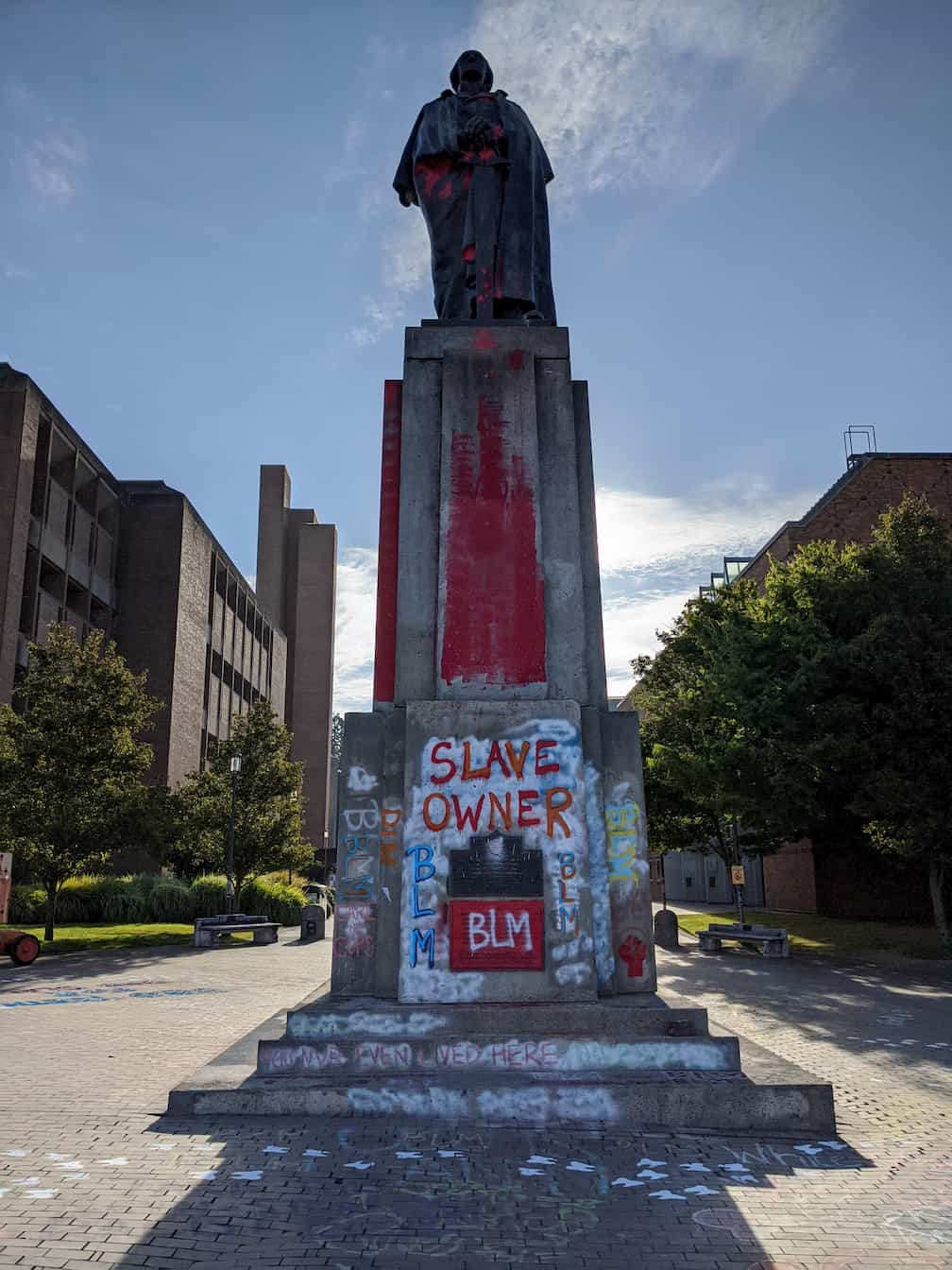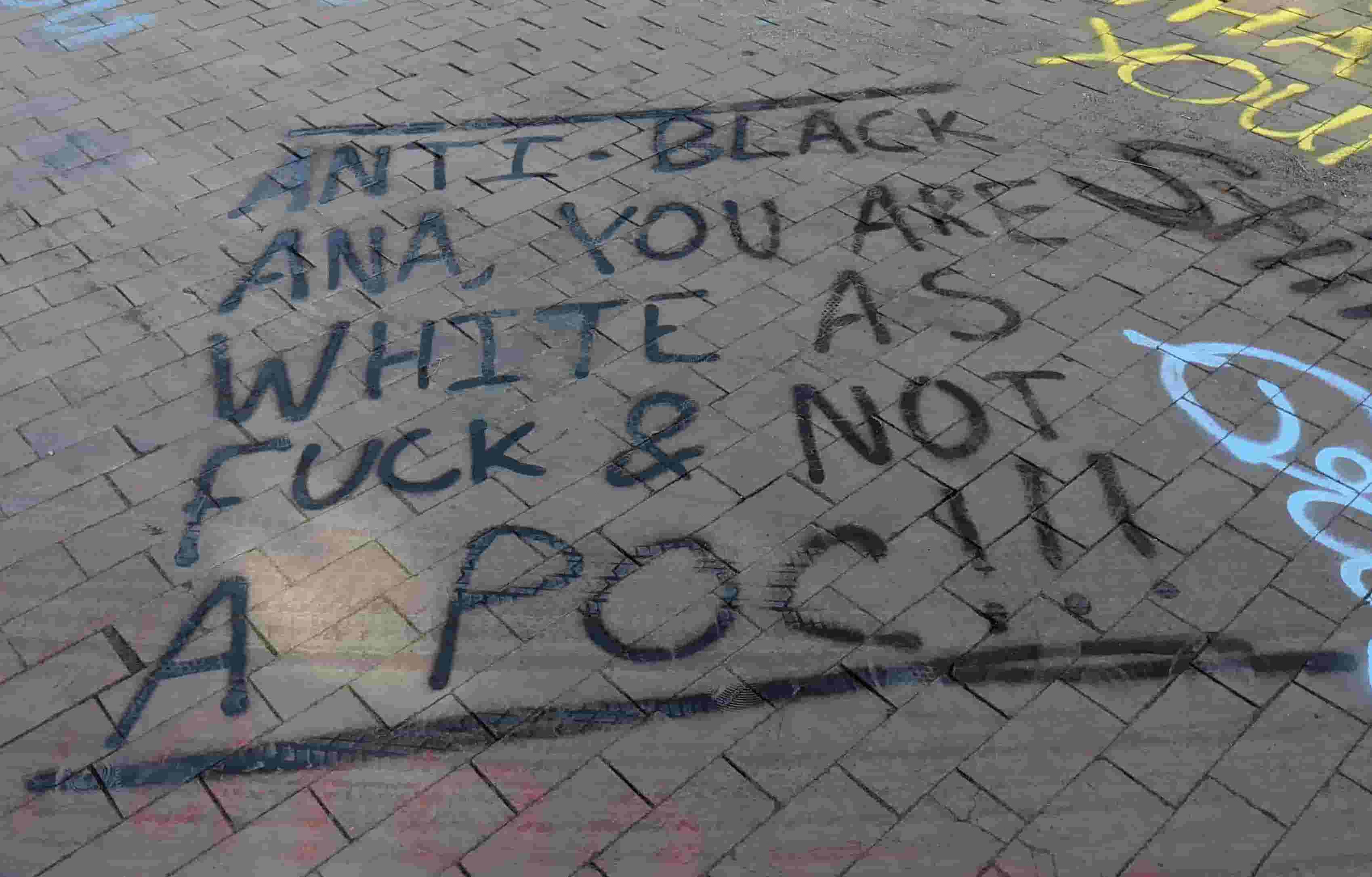Protests and Presidents at the University of Washington
Published 2020-10-24A large statue of George Washington looks west from the edge of the University of Washington (UW) campus in Seattle. When I was an undergraduate in 2004, the only thing I remember thinking about the statue was that its hands looked too big for its body. As far as I could tell, most students only noticed the statue insofar as it facilitated the punnily named By George, a nearby cafe. The fact that Washington’s too large hands were resting on a medieval longsword never struck me as odd. Years later, in Trafalgar Square, my guidebook led me to a statue of Washington resting a hand on a fasces . I had to turn to the internet to figure out what a fasces was and why an artist might think it appropriate to depict a figure of the American Revolution with a peculiar object from ancient Rome. George Washington probably never touched a longsword or a fasces, but seeing him hold them in a statue shouldn’t strike anyone as especially odd. Statues are symbols, not depictions of reality.
Symbols can mean different things to different people, of course. And this summer the Black Lives Matter (BLM) movement at the UW argued that the Washington statue symbolizes oppression and racism. Washington was a slave owner, after all. He fought for the freedom of white men and then governed a country with legalized slavery. Some claim his famous false teeth were torn from the mouths of unwilling slaves. Why should the university honor someone capable of such moral failings by keeping his statue? Removing statues like this one was one of seven demands BLM presented to the university administration.

The statue at one point during the protest. More pictures are available in this album.
For several weeks, protesters painted slogans on the statue and the surrounding plaza. At first the university removed them. The activists wrote that they would return until the statue came down, and eventually the administration let the slogans pile up. I took pictures for weeks as the scene evolved. At first, comments focused specifically on the statue. Eventually the police became a common theme. Perhaps most interesting, however, is the way many specifically targeted UW president Ana Mari Cauce.
The protests over the statue coincided with the appearance of posters around Seattle’s University District neighborhood labeling her “Anti-Black Ana” . This insult was also chalked around the statue, as was “sleepy Ana”, “Ana U Suck”, and admonishments that she had “chosen the wrong side of history”. Eventually the chalk was replaced by more colorful paint and more colorful insults. President Cauce was a “poo poo pee pee head” and a “millionaire”. They began to attack her identity. “Ana Mari is a white woman” was the first that I noticed in this vein. “Ana, break up with your boyfriend (George)" . “Anti-black Ana you are white as fuck and not a POC”. One illustrates her licking a boot , another calls her a coward exhibiting “caucasity” . The personal attacks on President Cauce are perplexing. She is a woman, a lesbian, a political refugee, and her brother was killed by the Ku Klux Klan. Her blog shows her to be sympathetic to current progressive causes, including diversity efforts.

Even compared to the quixotic demand to remove a statue of George Washington, at the University of Washington, in the US state of Washington, accusing President Cauce of being regressive is preposterous. Nevertheless, the protesters were heard. Last month ago she promised action on their demands, though not always to the extent they wanted. She isn’t able to mandate diversity requirements in the curriculum, for example, which is a responsibility of the faculty senate. But she did pledge to reduce the workforce at the University of Washington Police Department by 20%. On the question of the George Washington statue, she promised to add a plaque describing Washington as a slave owner. For the time being the graffiti has stopped. Perhaps the protesters are satisfied.
The furor over the statue is an example of the current debate over how we should view historical figures. In general, members of a local community calling attention to facts is perfectly acceptable. But there are three reasons why I think BLM’s demands to remove the statue, and then to be placated by a plaque, aren’t especially motivating. First, even if the statue was removed, both the University and the State would still be named for Washington. It is difficult for me to imagine the circumstances under which someone would feel legitimately threatened by the statue but be unperturbed by the name. In that light the demand to remove the statue can be seen more as an attempt to assert power than as a genuine interest in protecting the feelings of students.
Second, in the case of slavery, virtually everyone in the US today agrees that it was a horrific injustice. Plaques and counter-plaques litigating a universally accepted conclusion are slightly silly. The contradiction at the heart of the founding of the US, where men committed to liberty were willing to disenfranchise so many, is known to everyone in the US. A plaque is unlikely to provide much new information.
Finally, my most substantive criticism is that attacks on the statue betray what I see as a small-minded view of history. Instead, I propose that we would be better served by not insisting that a person’s bad actions invalidate their legacy. We should be able to remember the good without forgetting the bad. What I see as a flaw in the protester’s thinking can be seen in the following example.
Seattle is located in King County. It was originally named for William Rufus de Vane King, a vice president of the United States. In 1986 the County Council passed a motion to instead be named after Martin Luther King. William King was a slave owner, and MLK was deemed a more appropriate namesake for his contributions to civil rights. That commitment to civil rights is what MLK is popularly remembered for today.
How would we feel if protesters began focusing on MLK’s lamentable treatment of women? A statue of MLK could be honestly vandalized with “adulterer”, or “this man watched a rape and laughed”. Both charges appear to be true. But the vandalism would be misguided. Society doesn’t choose to remember MLK because he was a perfect human being that never did anything profoundly wrong. We remember him because he was a visionary that strove for a better world, in the face of extreme challenges, and was murdered for it.
It would be a loss if we threw out MLK as a symbol for his aspirational goals because he behaved monstrously towards women. The same criticisms of hypocrisy levied against Washington could also be turned against MLK. While he laughed at the rape, where was his concern for the content of the woman’s character? “Clearly,” the critics might say, “his entire theory of equality was false and empty, as it would have to be if spoken by a man that didn’t respect women”. And in a way they would be right. The fact that MLK could behave in such a way is completely at odds with our memory of him as a man that believed deeply in justice.
Yet we would be worse off had MLK not gifted us his vision for a better world. His vision was aspirational then, as it is now. What he did right is in no way lessened by what he did wrong. By all means, when we engage with MLK the man, an honest discussion of his treatment of women is appropriate. But statues of historical figures should not be viewed as monuments to their infallibility.
An honest view of the shortcomings of the past is critical. The protesters are right that we can’t allow ourselves to forget what Washington, or MLK, got profoundly wrong. But we can get more out of remembering what they got right. Progress is made by getting things right more than getting them wrong. The progress we have made is due to people like Washington moving us in the right direction, even if he didn’t move us far enough. MLK was then able to pick up the mantle and push us to be even better. Both are worth remembering. They are symbols of how history lurches forward, spurred on by human beings–flawed, imperfect, and sometimes great.
comments powered by Disqus